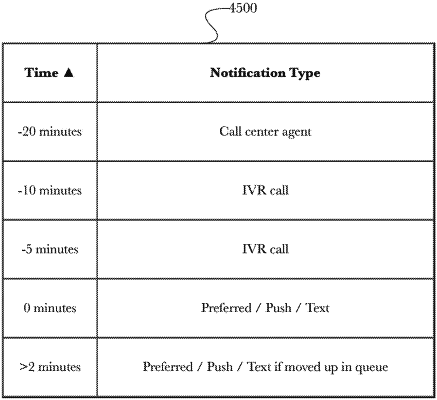| CPC H04M 3/5231 (2013.01) [H04L 67/306 (2013.01); H04M 3/5183 (2013.01)] | 10 Claims |

|
1. A system for enhanced virtual queuing with user-level targeted interactions, comprising:
a targeted interaction service comprising at least a processor, a memory, and a first plurality of programming instructions stored in the memory and operating on the processor, wherein the first plurality of programming instructions, when operating on the processor, cause the processor to:
receive user check-in information and user-specific metadata from a plurality of users;
identify one or more groups of the plurality of users based at least on the received user check-in information and the user-specific metadata;
determine one or more targeted interaction rules for the one or more identified groups;
use the user check-in information, the user-specific metadata, and the one or more targeted interaction rules to determine a recommended targeted interaction; and
provide the recommended targeted interaction to a user or identified group;
an accumulation service comprising at least a processor, a memory, and a second plurality of programming instructions stored in the memory and operating on the processor, wherein the second plurality of programming instructions, when operating on the processor, cause the processor to:
receive a request to join a virtual queue from two or more users forming a group;
accumulate positions in the queue totaling the number of users in the group;
send confirmation of the request to the group;
send periodic update notifications to the group based on a notification escalation plan, wherein the notification escalation plan comprises a rules-based multimodality means of communicating with the group;
receive a plurality of check-in notifications from an entity indicating the group has begun to check-in, or indicating how many persons in the group have already checked-in, or indicating the group has finished checking-in, the check-in notification comprising the check-in information; and
remove the group from the virtual queue;
wherein the request is selected from the group consisting of a request to join a queue, a request to leave a queue, a request to transfer to a different queue, a request for the current wait time of a queue, a request for additional time, a request to schedule a position in a queue for a later time, and a request to change places in a queue; and
a task blending service comprising at least a processor, a memory, and a third plurality of programming instructions stored in the memory and operating on the processor, wherein the third plurality of programming instructions, when operating on the processor, cause the processor to:
receive a plurality of data relating to the historical throughput of a queue;
model future iterations of the queue using the plurality of data;
determine times of low queue throughput;
reallocate computational resources used for queue simulations during times of low queue throughput;
use the reallocated computational resources for simulating new queue configurations for the duration of the low queue throughput;
analyze the new queue configuration simulations for an optimal configuration, wherein the optimal configuration is the simulation with the least wait time; and
output the difference between the current queue configuration and the optimal queue simulation as a set of recommendations.
|